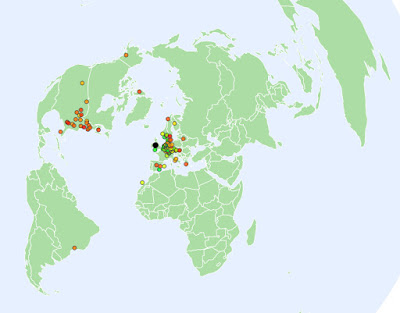Luckily, this was just a small porch, and I didn't yet want to spend a lot of money building a new roof for it. Instead, I covered up the OK-but-a-bit-rotted wood with some brass metal.
 |
| Never let bad neighbours and planning authorities put you off amateur radio! |
Hurrying to finish the job before it rained yet again, I realised the total length of metal was just over a quarter wavelength at 20m.
You know what's coming...
Yes, what better way to babtize my new rainproofing than to hook it up to some 300 Ohm ladder line running to a 4:1 balun, add a counterpoise draped over some bushes, and connect up via an ATU.
I set it off on WSPR this morning at a relatively high output of 2W, although this has to be set against the more typical output for 'real QSO' digimodes like JT65 and JT9 of about 10W.
First, here's the map of stations hearing me, and stations I heard with the porch over some 22 hours:
Next, only the stations that heard me over the same period:
And, finally, how the porch compared with the best WSPR station I know in the UK, who was running 200mW, some 10dB less than I was:
It's a remarkable observation on my QTH that a porch antenna continued to get spots during the depths of the summer night, whereas a full dipole didn't. Clearly, you wouldn't get this kind of result from a developed neighbourhood inland.
Overall, my peak distance using 2W comes in at precisely the same as the full dipole running 10dB less power, which gives a handy ballpark figure of how much the porch is 'down' on the dipole.
I think that's quite a remarkable result, and one that could never have been reached so objectively before the advent of WSPR. My spots signal-to-noise reports at 2W from DX stations broadly spanned -16 to -26dB. So, it's clear that running a more typical 10W with JT modes would certainly make this stealth antenna of practical use, with the proven potential to work the world.
Whilst I was writing this, I noticed something rather remarkable: Alaskan station, KL7L, was receiving me (with the antenna now more of a vertical than yesterday's horizontal efforts) at -23dB, one of only four EU stations he was hearing at all over the past couple of hours (and two of those were using stupidly-high outputs of 10W and 50W - on WSPR!) Here's the evidence:
A simple tweak that will improve the antenna significantly is to turn it into more of a vertical configuration. I simply took the 'counterpoise' and threw it up over one side of the roof. That then becomes the radiator, with the porch metal becoming the return path. Here's how the results look.
First, all stations hearing me:
I wasn't able to compare with the GI station yesterday, as he wasn't operating. Instead, I compare with another 'reference' WSPR station, running an inverted-L antenna. Ignore the dip in my signal at centre, caused simply by the WSPR software being terminated by my laptop for some bizarre reason:
Finally, a plot of the spread of signal strengths, relative to the inverted-L:
Altogether, it's clear that the wire thrown up on the roof, with the porch metal acting as the counterpoise, works really very well. The reported signal strengths in VK, for example, are around -26dB S/N, which certainly puts them within reach on JT or other weak signal modes.
There is, rather obviously, no claim here that, where you have the space and friendly neighbourhood, you should put this antenna up instead of a full-sized antenna in the clear. Instead, it started off simply as a 'let's see' experiment that reveals that, for difficult neighbourhoods and small spaces, this throw-it-up stealth antenna really can work well on weak signal modes.







2 comments:
The trouble is that it is well known that signals travel much further then when a human is next to the radio. Same effect when I am on JT modes, never get answered by anybody close to the furthest station automatically spotting me.
Yes, that can certainly be true, if one simply looks at 'how far away' the signal is heard. This can be a valid criticism of some aspects of WSPRlite and DXPlorer, for example (though efforts to improve those are ongoing).
With a wire thrown up on the roof, the signal is much better, and the strengths reported by spotters (in S/N ratio, just as in JT modes) certainly means that JT modes would work well.
Sure, there are much better arrangements, but for those whose neighbours or HOAs are hell-bent on stamping out diversity in society on the basis of their own prejudices, then this does offer hope.
Post a Comment